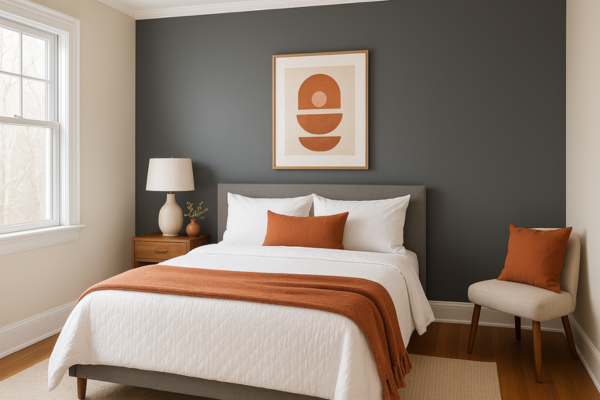The Stress-Free Way to Choose Paint Colours For Your Entire Home
AI-generated image - Suite Minded
If you're staring at paint swatches and Pinterest boards feeling completely overwhelmed… you’re not alone. Figuring out how to choose paint colours for your home can feel like a daunting task. It’s not just about picking pretty colours. You want your home to feel cohesive, reflect your personality, and still look great in different lighting and rooms. But here’s the good news: it doesn’t have to be stressful.
There’s a simpler, calmer way to approach this. One that helps you build a whole house colour palette that flows naturally from room to room, without second-guessing every choice or feeling like you need a design degree to get it right. Let’s walk through a stress-free, step-by-step method for choosing interior paint colours with confidence.
Why choosing paint colours can feel so overwhelming
Let’s start with the obvious: there are thousands of paint colours out there. Whites with warm or cool undertones. Greys that shift blue or green in the light. Beiges that somehow turn pink once they’re on your wall. On top of that, every room in your home has different lighting. North-facing rooms make colours appear cooler. Afternoon sun can warm things up. Your floors, cabinetry, countertops, and furniture also affect how paint looks in real life.
Most people try to figure it out room by room and end up with mismatched colours. If you’ve ever felt frustrated that a colour looked perfect in the shop but awful at home, you’re not alone. You don’t need a better eye, you just need a better system.
AI-generated image - Suite Minded
Step 1: Define the mood of your home
Before you start picking paint, take a moment to define the overall feel you want for your home. Do you want it to feel calm and coastal? Clean and minimal? Warm and traditional?
Choosing your home’s mood gives you a good base point to follow for every decision. It helps you eliminate colours that don’t fit, and focus on what supports the overall feeling you want in your space.
Step 2: Choose your main neutrals and anchor points
Start with your foundation: the neutral paint colours that will show up in multiple places (walls, ceilings, trim, cabinetry).
Look at the permanent or semi-permanent elements in your home: flooring, tiles, countertops, and large furniture pieces. These are your anchor points, and your paint colours should support them, not clash. Analyse the undertones of these elements to make sure your foundation colour pairs well with them.
A beautiful neutral like Benjamin Moore’s White Dove or Dulux Natural White might seem simple, but choosing the right neutral paint colour is what ties everything together.
Staring at countless paint samples and feeling stuck and overwhelmed? The Confident Home Colour Blueprint gives you a clear, step-by-step plan to choose colours that actually work, without wasting weeks second-guessing or repainting.
Step 3: Pick one or two base wall colours
Instead of choosing a new colour for every room, choose one or two versatile wall colours that flow through your main living areas and hallways.
When choosing paint colours, always test them in different rooms and at different times of day. Natural light, shadows, and bulb temperature can completely shift how a colour looks. Understanding undertones and LRV (Light Reflectance Value) will help you avoid unexpected surprises.
AI-generated image - Suite Minded
Step 4: Layer in accent colours, room by room
Accent colours add personality without disrupting flow. A navy blue island in the kitchen, a soft sage green in the powder room, a blush pink in the nursery. Choose accent colours that coordinate with your base palette. They should contrast just enough to feel intentional, not random.
Step 5: Ensure colour flow between rooms
Walk through your home and look at how the colours interact from room to room. Open-plan living? Long hallways? Make sure there are no jarring transitions. A good home paint colour scheme feels cohesive but not boring. You want consistency with a few moments of contrast or warmth.
Use undertones (warm, cool, neutral) and LRV (Light Reflectance Value) to help guide your decisions. Aim for colours that harmonise, even if they aren’t all exactly the same.
AI-generated image - Suite Minded
Extra tips to keep it stress-free
Use fewer colours, not more. Stick to 3–5 main colours for your whole home, especially if you feel overwhelmed by paint colour choices and not quite confident yet.
Always test samples in multiple rooms. Paint on A4 sheets and move them around to see how they respond to different lighting. Place them next to those elements that don’t change, such as your flooring, countertops, tiles, etc… I can’t stress this enough, but sampling your colour options correctly is key.
Compare colours side-by-side. Lay out your full palette and make sure they work nicely together; don’t rely on memory or what they look like on the small paint swatches at the store.
Still feeling stuck choosing paint colours?
If you’re still unsure, don’t worry. This is exactly why I created the Home Paint Colour Blueprint.
A complete step-by-step system to help you:
Choose paint colours that feel calm, cohesive, and timeless
Understand undertones, LRV, and what works in your home’s lighting
Build a whole house palette using Benjamin Moore’s most beautiful shades
Whether you're starting fresh or working with existing finishes, the Blueprint makes the process easy, empowering, and, most importantly, stress-free.
You don’t need to feel overwhelmed every time you pick up a paint swatch. Once you know how to choose paint colours for your home in a thoughtful, strategic way, everything gets easier. Take it step by step. Stay grounded in the mood you want to create. And remember, you’re not alone in this.
If you want help building your full-home colour scheme, the Home Paint Colour Blueprint-Benjamin Moore Edition is here to guide you every step of the way.




